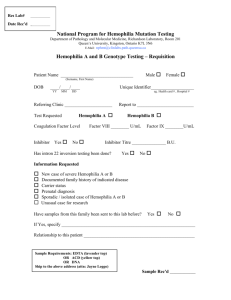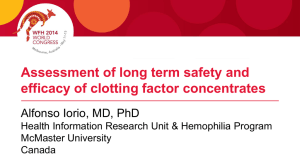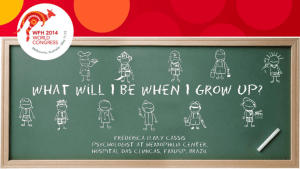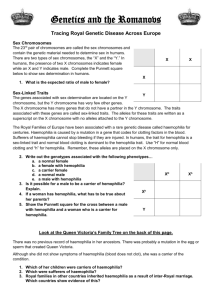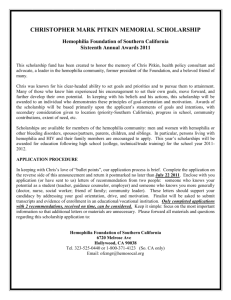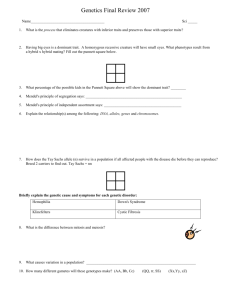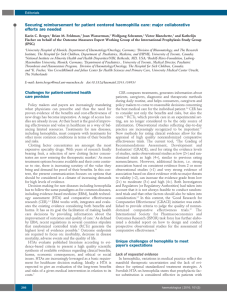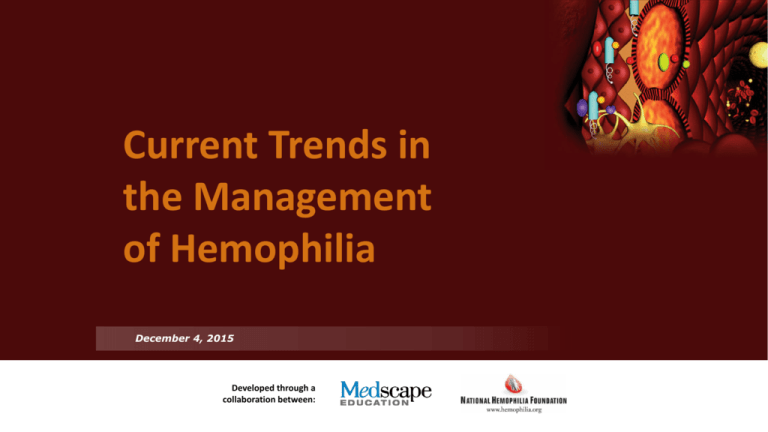
Current Trends in
the Management
of Hemophilia
December 4, 2015
Developed through a
collaboration between:
Moderator
Maria Elisa Mancuso, MD, PhD
Haematologist, Angelo Bianchi Bonomi Hemophilia and Thrombosis Center
Fondazione IRCCS Ca' Granda Ospedale Maggiore Policlinico
Department of Pathophysiology and Transplantation
University of Milan
Milan, Italy
2
To submit questions, please text them to 609-400-1695
Panelists
Margaret V. Ragni, MD, MPH
Professor of Medicine
Division of Hematology/Oncology
Director
Hemophilia Center of Western Pennsylvania
University of Pittsburgh
Pittsburgh, Pennsylvania
Craig M. Kessler, MD
Professor of Medicine and Pathology
Director, Division of Coagulation
Hemophilia and Thrombosis Comprehensive Care Center
Georgetown University Medical Center
Washington, DC
Johannes Oldenburg, MD, PhD
3
Professor
Institute of Experimental Haematology and Transfusion Medicine
University of Bonn
Bonn, Germany
To submit questions, please text them to 609-400-1695
Directions
Submitting Questions
• To submit questions to the panel, please email my.question.is1@gmail.com
• OR text 609-400-1695
• Audience members can submit a question to the faculty at any time during the program. We
may not be able to answer all due to time constraints.
Answering the Poll Questions With the Worldwide Keypad
• To use the keypad, simply press the number that corresponds with the option you wish to
choose.
• There is no enter button.
• If you make a mistake, you can revote at any time during the polling period.
4
• At the end of the event please leave the keypads on your chair.
Introduction
Maria Elisa Mancuso, MD, PhD
Haematologist, Angelo Bianchi Bonomi Hemophilia and
Thrombosis Center
Fondazione IRCCS Ca' Granda Ospedale Maggiore Policlinico
Department of Pathophysiology and Transplantation
University of Milan
Milan, Italy
Developed through a
collaboration between:
Learning Objectives
• Identify key data concerning advances in prophylaxis and the use
of extended half-life factor replacement for hemophilia A and B
• Evaluate key clinical issues associated with advances in
hemophilia care, including monitoring and genotyping
• Determine best practice management strategies through the
presentation and discussion of cases
6
To submit questions, please text them to 609-400-1695
EHL Products
How Far Are We?
• EHL products promise a paradigm shift in treatment
• Fewer infusions, longer and higher protection, increased
adherence, and improved QoL
• Treatment individualization seems to be the key: not a standard
regimen for all
• Treatment tailoring according to patient characteristics
7
To submit questions, please text them to 609-400-1695
EHL and Prophylaxis
Moving From the Clinic to the Real World
Margaret V. Ragni, MD, MPH
• Overview of approved EHL products
• Impact of EHL on prophylaxis
• Longer half-life vs higher trough levels
• Management of the active adolescent
8
To submit questions, please text them to 609-400-1695
Monitoring New Products
• Rationale for monitoring: when and who
• Adapt activity to half-life and vice versa
• What is important for healthcare providers
• What is important for patients
• Available assays and their interpretation
9
To submit questions, please text them to 609-400-1695
Monitoring the Standard and New Products
Conundrums of Clinical Care
Craig M. Kessler, MD
• Rationale for monitoring
• Concept of extended half-life
• Challenges to monitoring
• Available assays
• Different monitoring for different patients
10
To submit questions, please text them to 609-400-1695
The Impact of Genes and Genetics
• Hemophilia is a congenital disorder due to genetic mutations
• Genotyping as a driver for interpreting clinical phenotype
• Exploring the impact of genotype-phenotype on clinical practice
and patient management
• Genotyping for all?
• The role of genetic counseling
11
To submit questions, please text them to 609-400-1695
Genotyping and Phenotyping
Scientific and Practical Implications
Johannes Oldenburg, MD, PhD
• What do we know about genotype-phenotype relationship
• What can we do with genotyping?
• Who is a candidate?
• The role of genetic counseling
12
To submit questions, please text them to 609-400-1695
EHLs and Prophylaxis
Moving From the Clinic
to the Real World
Margaret V. Ragni, MD, MPH
Professor of Medicine
Division of Hematology/Oncology
Director
Hemophilia Center of Western Pennsylvania
University of Pittsburgh
Pittsburgh, Pennsylvania
Developed through a
collaboration between:
Treatment Timeline
14
First case of hemophilia in US
1803
First whole blood transfusion
1840
Queen Victoria -- hemophilia
1843
Deficiency of factor VIII, IX
1930s
Plasma
1936
Cryoprecipitate
1964
Clotting factor: VII, IX, PCC
1960-80s
FIX, FVIII genes cloned
1982-84
Liver transplant: cure
1985
Recombinant factor VIII, IX, VIIa
1992-99
Extended Half-Life VIII, IX
2010-15
Queen Victoria’s Family
To submit questions, please text them to 609-400-1695
Introduction
• Exciting time in clot factor management:
– Extended half-life proteins for hemophilia
• Paradigm shift in treatment:
1. Fewer infusions
2. Longer protection from bleeds
3. Improved quality of life
4. Reduced immunogenicity
15
To submit questions, please text them to 609-400-1695
Overview
• FDA-approved EHL products
– rFVIIIFc: Recombinant factor VIII-FC fusion protein
– rFIXFc: Recombinant factor IX-Fc fusion protein
– PEG-rFVIII: pegylated, full-length recombinant factor VIII
• Phase 3 pivotal studies
–
–
–
–
Mahlangu J, et al: rFVIIIFc fusiona
Powell JS, et al: rFIXFc fusionb
Collins PW, et al: glycoPEGylated factor IX (N9-GP)c
Konkle BA, et al: PEG-rFVIIId
• Safety, efficacy, and pharmacokinetics
• Implementation in clinical setting
• Case discussion
16
a. Mahlangu J, et al. Blood. 2014;123:317-325; b. Powell JS, et al. N Engl J Med. 2013;369:2313-2323;
c. Collins PW, et al. Blood. 2014;124:3880-3886; d. Konkle BA, et al. Blood. 2015;126:1078-1085.
The Hemophilias
Defect
• Deficient, defective FVIII, FIX
Genetics
• X-linked Disorder
Clinical
• Bleeds into joint, muscles
Severity
• Mild (> 5%) traumatic
• Moderate (1-5%) traumatic
• Severe (< 1%) spontaneous, traumatic
Morbidity
• Spontaneous joint bleeds
Goal
• Prevent bleeds by maintaining > 1%
Prince Alexei
Half-Life
• FVIII: 8-12 h; FIX: 12-24 h
Dosing
• FVIII: 3/wk; FIX: 2/wk
17
To submit questions, please text them to 609-400-1695
Factor Level and Bleed Risk
Predicted Bleeds per Year
Prophylaxis: FVIII, IX dosing to prevent spontaneous bleeds
Time With Factor VIII < 1 IU dL-1, h/wk-1
18
Risk: Spontaneous bleeds increase as time < 1% increases
Goal: Maintain factor > 1% to prevent spontaneous bleeds
Collins PW, et al. J Thromb Haemost. 2009;7:413-420.
Prophylaxis Landmark Study
• Randomized Trial -- Hemophilia A age < 30 mo (N = 65)
• Aim -- To determine if prophylaxis (3,4/wk) prevents joint disease
Prophylaxis
(N = 32)
Standard
Therapy
(N = 33)
P Value
No joint damage (MRI), %
93
55
.002
No joint damage (X-ray), %
96
81
.10
Median no. joint bleeds, no. patients/y
.20
4.35
< .001
Inhibitor formation, %
6.2
0
.24
Life-threatening bleeds, %
0
9
.24
CVAD infections, %
91
76
.19
Conclusion: Prophylaxis prevents joint damage and bleeds
19
Manco-Johnson MJ, et al. N Engl J Med. 2007;357:535-544.
To submit questions, please text them to 609-400-1695
Problems With Prophylaxis
Prophylaxis
• Reduces joint bleedsa
• Reduces joint damage by MRI
• Standard of care for severe hemophilia
Problems
• Requires frequent injections: FVIII 3/wk; FIX 2/wk
• Invasive, costly: 50% of adults avoid prophylaxisb
• Ports, access: most children receive ~1/wk dosec
20
a. Manco-Johnson MJ, et al. N Engl J Med. 2007;357:535-544; b. Walsh CE, Valentino LA. Haemophilia. 2009;15:1014-1021;
c. Ragni MV, et al. Haemophilia. 2012;18:63-68.
EHL FVIII and FIX Proteins
Fc-IgG fusion proteins
• rFIXFca
• rFVIIIFcb
Albumin-fusion proteins
• rFIX-FPc
Pegylated/glycoPEGylated proteins
• N9-GPd
• N8-GPe
• BAY 94-9027f
• PEG-rFVIIIg
21
a. Powell JS, et al. N Engl J Med. 2013;369:2313-2323; b. Mahlangu J, et al. Blood. 2014;123:317-325; c. Santagostino E, et al. ISTH 2015. Abstract
OR347; d. Collins PW, et al. Blood. 2014;124:3880-3886; e. Tiede A, et al. J Thromb Haemost. 2013;11:670-678; f. Coyle TE, et al. J Thromb Haemost.
2014;12:488-496; g. Konkle BA, et al. Blood. 2015;126:1078-1085.
EHL Proteins
Protein
Phase
Dose
(IU/kg)
Subjects
ABR
Response
Inhibitor
Half-life
Recombinant FVIII EHL Proteins
rFVIIIFca
III
25-50
2/wk
N = 165
2.9
97.8%
0.0%
1.5-fold (19 h)
N8-GPb
III
50
q 4d
N = 175
1.3
95.5%
0.0%
1.5-fold
(18.3 h)
BAY 94-9027c
III
25-60
1-2/wk
N = 132
1.5
--
0.0%
1.4-fold
(18.7 h)
PEG-rFVIII
III
45
2/wk
N = 101
1.9
95.9%
0.0%
1.4-1.5-fold
Recombinant FIX EHL Proteins
22
rFIXFce
III
50-100
q 7-10d
N = 61
2.0
97.3%
0.0%
2.5-fold (82 h)
rFIX-FPf
III
50-75
q 7-14d
N = 63
--
98.6%
0.0%
> 5.0-fold
(105 h)
N9-GPg
III
40
q wk
N = 29
1.0
100.0%
0.0%
2.5-fold (93 h)
a. Mahlangu J, et al. Blood. 2014;123:317-325; b. Giangrande P, et al. J Thromb Haemost. 2015;13. Abstract OR212; c. Boggio LN, et al. Blood.
2014;124. Abstract 1526; d. Konkle BA, et al. Blood. 2015;126:1078-1085; e. Powell JS, et al. N Engl J Med. 2013;369:2313-2323;
f. Santagostino E, et al. ISTH 2015. Abstract OR347; g. Collins PW, et al. Blood. 2014;124:3880-3886.
EHLs: Clinical Trials Update
Phase 3 Clinical Trials
• Safe, well tolerated
• Improved t½, recovery; delayed clearance
• No inhibitor development
• No allergic reactions
• No thrombosis
• Efficacy comparable to rFVIII, rFIX
• Safety comparable to rFVIII, rFIX
23
To submit questions, please text them to 609-400-1695
EHL Dosing
3%
1%
SHL: 25-25-50 U/kg TIW rFVIII
EHL: 25/65 U/kg BIW rFVIIIFc
24
SHL: 75-100 U/kg BIW rFIX
EHL: 75-100 U/kg 1/wk rFIXFc
Republished with permission of the American Society of Hematology from Mahlangu J, et al. Blood. 2014;123:317-325; permission conveyed through
Copyright Clearance Center, Inc.; From Powell JS, et al. N Engl J Med. 2013;369:2313-2323. Copyright © 2013 Massachusetts Medical Society.
Reprinted with permission from Massachusetts Medical Society.
EHL: Potential Implications
• Longer duration factor level > 1% factor
• Less frequent infusions
• Fewer ports, ED visits
• Fewer interruptions of school, work
• Improved QoL
25
To submit questions, please text them to 609-400-1695
EHL Improves Half-life, AUC
• A FVIII level > 1% was sustained in ~50% of adults receiving
rFVIIIFc 50 U/kg q5d in phase 2 trial
• Yet they had continued protection against bleeds
– Prolonged AUC (time spent > 1%) prevents bleeds
26
Republished with permission of the American Society of Hematology from Mahlangu J, et al. Blood. 2014;123:317-325; permission conveyed through
Copyright Clearance Center, Inc.
AUC: SHL vs EHL
Upper Panel:
SHL
Lower Panel:
EHL
• For a once-weekly EHL protein to achieve a similar trough to an alternateday SHL protein, the peak will need to be higher, with a longer time spent
below a "critical level" and fewer peaks during the week
SHL = standard half-life; EHL = extended half-life
27
Mahdi AJ, et al. Br J Haematol. 2015;169:768-776.
To submit questions, please text them to 609-400-1695
FVIII Trough and Prophylaxis
• Prophylaxis Study
– Dose to achieve FVIII ≥ 1% differs by patient
– Thus, individualized dosing may be more effective
• PK-Guided Prophylaxis Study in 34 severe hemophilia A patients
– Individual dose to achieve trough 1% VIII determined
– Individual trough to prevent bleeds determined
– Individual PK and bleeds for optimal prophylaxis modeled
• Median FVIII at Bleed (N = 34)
– Joint Bleeds: 3.43 U/dL (0-42)
– Other Bleeds: 2.87 U/dL (0-11)
– Spontaneous: 2.71 U/dL (0-26)
28
Spotts G, et al. Blood. 2014;14. Abstract 689.
To submit questions, please text them to 609-400-1695
FVIII Trough and Prophylaxis
Minimally Effective Trough Target Trial
Trough, %
Number
Bleed-Free, %
≥1
15/34
44
≥3
20/34
59
≥5
26/34
76
≥ 10
29/34
85
≥ 15
32/34
94
≥ 20
33/34
97
≥ 25
33/34
97
≥ 30
34/34
100
• Findings: 76% predicted to be bleed-free at VIII ≥ 5%; and 94% at > 15%
• Conclusion: Individualized PK provides personalized prophylaxis regimen
29
Spotts G, et al. Blood. 2014;14. Abstract 689.
To submit questions, please text them to 609-400-1695
What Is the Real-World Impact of EHLs?
• Bleed type, frequency
– Will EHLs delay onset and reduce type and frequency of bleed?
• Prophylaxis
– Will EHLs simplify, encourage; at what dose and what trough?
• Chronic joint disease
– Will EHLs slow onset of joint disease, severity, surgery?
• Inhibitor formation
– Will EHLs reduce inhibitor frequency, titer, or shorten ITI?
30
To submit questions, please text them to 609-400-1695
Impact of Implementing EHLs
• Prophylaxis, bleeds, joint disease
– To demonstrate reduced ABR, infusion, time < 1%, improved joint
preservation and lifestyle
Prospective data collection: PINKLINK, QoL, PK, Cost-Effect Studies
• Inhibitor formation, tolerance
– To demonstrate reduced immunogenicity, shorter and simpler immune
tolerance induction
Prospective data collection: INHIBIT Study, HIRE Study
31
To submit questions, please text them to 609-400-1695
Impact of EHL: Local Experience
At HCWP, since 2014 FDA licensure: N=73 switched to EHL
Hemophilia A
(N = 52)
Switched to rFVIIIFc
Hemophilia B
(N = 21)
Switched to rFIXFc
PTPs (2 doses/wk)
PTPs (1 dose/7-10/d)
• < 1 y (N = 4)
• < 18 y (N = 33)
• rFVIIIFc ITI (N = 3)
32
Ragni, M. unpublished data.
To submit questions, please text them to 609-400-1695
Impact of EHL: Considerations
1.
Prophylaxis
– Initiate at 1st bleed once weekly
2.
Breakthrough bleeds
– Escalate to twice weekly
3.
Inhibitor prone-children
– Dose once weekly before bleed
4.
Inhibitor patients
– Initiate ITI as alternate day therapy
5.
Personalized Rx
– Use trough to adjust dose to > 1%
6.
Growth spurt
– Monitor q 3-6 months in children, adolescents
7.
Ongoing bleeds
– Discuss treatment duration, frequency
8.
Sports
– Assess troughs and dose frequency
33
To submit questions, please text them to 609-400-1695
What Is Optimal Therapy?
"Quotable Quotes" for consideration
• The optimal trough is ~1%
• EHLs are for severe patients only
• EHLs are for prophylaxis patients only
• EHLs should not be used in infants
• EHLs are not for inhibitor patients
34
To submit questions, please text them to 609-400-1695
What Is Optimal Therapy?
“Quotable Quotes” for consideration:
• The optimal trough is ~1%
NOT NECESSARILY
• EHLs are for severe patients only
NOT NECESSARILY
• EHLs are for prophylaxis patients only NOT NECESSARILY
35
• EHLs should not be used in infants
NOT NECESSARILY
• EHLs are not for inhibitor patients
NOT NECESSARILY
To submit questions, please text them to 609-400-1695
EHL and Inhibitor Formation
What Is the Evidence?
• Fc contains Tregs that suppress immune responsea
• Ig antibodies coupled to haptens induce Ag-specific toleranceb
• In hem A mice, weekly rFVIIIFc reduces inhibitors (vs rFVIII)b
• EHL activate, expand T regulatory epitopes, reduce immunogenicity
– Fc Fusion proteinsc,d
– Albumin Fc proteinse
– Pegylated proteinsf,g
• Inhibitor formation: lower titer, more rapid toleranceh
36
a. Rath T, et al. Crit Rev Biotechnol. 2015;35:235-254; b. Lei TC, Scott DW. Blood. 2005;105:4865-4870; c. Borel Y. Immunol Rev. 1980;50:71-104. d. De
Groot AS, et al. Blood. 2008;112:3303-3311; e. Basto AP, et al. Mol Immunol. 2015;64:36-45; f. Chapman AP. Adv Drug Deliv Rev. 2002;54:531-545. g.
Hershfield MS. In Poly(ethylene glycol): chemistry and biological applications. 134-44. h. Malec LM, et al. ASH 2015. Abstract 3531.
Patient Management Issues
• Is clinical or laboratory monitoring necessary to manage patients
using long-lasting products?
• Is PK needed to determine optimal dose?
• Are breakthrough bleeds sufficient monitoring?
• When should the prophylaxis dose be increased, decreased?
37
To submit questions, please text them to 609-400-1695
Clinical Case: Presentation
Adolescent active in sports on prophylaxis
• 15-year-old with moderately severe hemophilia B
• Basketball practice twice/wk, game weekends
• Current rFIX prophylaxis: 1-2/wk at night
• Recent hip bleed, and recurrent ankle bleeds
• Growth spurt, next visit in 6 months
38
To submit questions, please text them to 609-400-1695
Clinical Case: Questions
How would you manage this patient’s prophylaxis?
1. Remain on his regimen
2. Increase frequency of the current rFIX regimen
3. Switch to EHL every 7 days
4. Switch to EHL every 10 days
39
Clinical Case: Questions
We decided to switch the patient to an EHL.
What starting dose would you use?
1. 75 U/kg once weekly
2. 75 U/kg every 10 days
3. 100 U/kg once weekly
4. 100 U/kg every 10 days
40
Clinical Case: Management
Adolescent active in sports on prophylaxis
• 15-year-old with moderately severe hemophilia B
• Basketball practice twice/wk, game weekends
• Current rFIX prophylaxis: 1-2/wk at night
• Recent hip bleed, and recurrent ankle bleeds
• Growth spurt, next visit in 6 months
Begun on rFIXFc 75 U/kg/wk: Breakthrough Bleeds
41
75 U/kg/wk
100 U/kg/wk
Peak
1.01
--
U/mL
Trough
0.01
0.02
U/mL
Conclusion: Personalized Approach
• Sports
–
Invincibility with responsibility
• Transition issues
–
Self-infusion, adjusted to practice, games
• One size does not fit all
–
Get peaks, troughs
• Growth spurt
–
Get frequent weights!
• Infants/children
–
Once-weekly EHL prophy may be optimal
• Realistic expectations
–
Assess adherence, arthropathy
• Adherence
–
May not improve with EHL
• Chronic arthropathy
–
42
May not improve with EHL
To submit questions, please text them to 609-400-1695
Monitoring the Standard
and New Factor
Replacement Products
Conundrums of Clinical Care
Craig M. Kessler, MD
Professor of Medicine and Pathology
Director, Division of Coagulation
Hemophilia and Thrombosis
Comprehensive Care Center
Georgetown University Medical Center
Washington, DC
Developed through a
collaboration between:
Presentation Overview
• Rationale for monitoring: Understanding PK
• Challenges to monitoring
• Available assays
• Case study
44
To submit questions, please text them to 609-400-1695
Hemophilia Clinical Trial Pipeline
Hemophilia With
Inhibitors
New Recombinants
• BAX817 – rFVIIa
• Transgenic rhFVIIa
Longer-acting
• OBI-1 – rpFVIII
• CB813d – rVIIa analogue
• CSL689 – rVIIa:albumin
fusion
• rVIIa:CTP
Hemophilia B
New Recombinants
• IB1001 – rFIX
• BAX326 – rFIX *
45
* = Approved
Longer-acting
• rFIX:Fc*
• CSL654 – rFIX:albumin
fusion
Hemophilia A
New Recombinants
• simoctogog alfa –
rFVIII
• octocog alfa sucrose
plasma protein-free–
rFVIII
• GreenGene F - rFVIII
Longer-acting
• rFVIII:Fc*
• BAY94-9027 – PEGylated
rFVIII
• BAY855 – PEGylated
rFVIII*
• CSL627 – SingleChain
rFVIII
Cross-Segment
Longer-acting
• MC710 – pdFVIIa + pdFX
• ACE910 – SC bispecific Ab
• siRNA vs Antithrombin
Premise of Prophylaxis Therapy in Hemophilia
• Patients with mild/moderate hemophilia (ie, residual factor levels ≥ 1%)
bleed less frequently and have less arthropathy
• > 1% selected for existing economics and treatment protocol burden
– Venous access and frequency of dosing 2-3X/wk for FVIII
• Animal models show that every single bleed matters and can cause
irreversible damage when it occurs in the brain, solid organs, or joints
• 1% trough level is too low to prevent all bleeds, particularly with active
lifestyles or those with established joint damage
46
"FVIII/FIX levels of 1% limit the ability for full social integration equivalent to
someone without a bleeding disorder. It is wholly insufficient to
accommodate major or accidental trauma causing bleeding. The fear of
traumatic injury remains a constant."
Skinner MW. Haemophilia. 2012;18:3-5.
To submit questions, please text them to 609-400-1695
Percent Factor Level
Understanding the Curve
Infusion
Peak
following
infusion
Peak range
Area under
the curve
Trough
• Peak range
– May help prevent
activity-related
bleedsa,b
• Area under the curve
– May help prevent
subclinical bleedinga
• Trough
– May help prevent
spontaneous
bleedinga,c
Time
47
a. Collins PW, et al. Haemophilia. 2011;17:2-10; b. Collins PW. Haemophilia. 2012;18:131-135; c. Collins PW, et al. J Thromb Haemost. 2009;7:413-420.
Risk Associated With Activity Is Highly Variable
• NHF has rated certain activities
based on their perceived risk
1
1.5
2
2.5
3
Safe
Safe to Moderate risk
Moderate risk
Moderate to Dangerous risk
Dangerous
48
Anderson A, et al. Playing It Safe: Bleeding Disorders, Sports and Exercise. 2005.
To submit questions, please text them to 609-400-1695
Category 2 vs Category 1 Activities Are Associated With
Increased Risk of Bleeding
• Increased activity level is
associated with an
increased propensity to
bleed
• More factor is required to
reduce the level of risk to
the same as category 1
• There is still a high risk of
bleeding at 100% factor
level
49
Broderick CR, et al. JAMA. 2012;308:1452-1459. Copyright © 2012 American Medical Association. All rights reserved.
Category 3 Activities Associated With
Highest Risk of Bleeding
• Category 3 activity is
associated with the highest
propensity to bleed
• Even more factor is required
to reduce the level of risk to
the same as category 1
• There is still a risk of bleeding
at 100% factor level
50
Broderick CR, et al. JAMA. 2012;308:1452-1459. Copyright © 2012 American Medical Association. All rights reserved.
Data Highlight Transient Nature of Bleed Risk
• Most patients experienced between 0-2 bleeds per year
• Bleeding rate did not vary by the week of the year
• Most bleeds occurred within 1 h of activity
Bleed Window
51
Broderick CR, et al. JAMA. 2012;308:1452-1459. Copyright © 2012 American Medical Association. All rights reserved.
Key Takeaway Lessons From Broderick 2012
• Increased potential for collisions is associated with an increase in
the risk of bleeding
• Increasing factor levels can decrease the risk of bleeds
– 1% increase in factor = 2% decrease in risk
• Most bleeds associated with physical activity are apparent within
an hour
– Suggests the need to have highest factor levels during
the time of highest risk
52
Broderick CR, et al. JAMA. 2012;308:1452-1459.
To submit questions, please text them to 609-400-1695
US Joint Outcome Study
Study Protocol
Age < 30 months
FVIII ≤ 2%; no inhibitors
≤ 2 joint hemorrhages
Randomize
Prophylaxis
rFVIII 25 U/kg alternate days
Episodic
No routine infusions
Treatment of Acute Joint Bleed
40 U/kg immediately
20 U/kg at 24 & 72 h
20 U/kg alternate days until complete resolution of
pain and normal physical exam, up to 4 weeks
Exit: Joint Outcome on
MRI & X-Ray at Age 6 y
53
Manco-Johnson MJ, et al. N Engl J Med. 2007;357:535-544.
Primary Outcome
Proportion of Children With No
Cartilage/Bone Changes on MRI in the 6
Index Joints at Study Exit
Median number of joint bleeds
Prophylaxis vs Episodic arm:
Episodic -- 55%
0.2 vs 4.35/y
Prophylaxis → 83% relative risk
Prophylaxis -- 93%
0
54
20
40
60
80
reduction
100
Number of Children, %
Manco-Johnson MJ, et al. N Engl J Med. 2007;357:535-544.
To submit questions, please text them to 609-400-1695
Subclinical Bleeds by Joint Score in All Patients
10
9
Damaged
joints
8
7
MRI Score
Some joints
with no
hemorrhages
had high MRI
scores
6
Some joints with
>10 hemorrhages
had no
bone/cartilage
damage
5
4
3
2
1
0
0
5
10
15
20
25
Number of Clinically Evident Index-Joint Hemorrhages
55
From Manco-Johnson M, et al. N Engl J Med. 2007;357:535-44. Copyright © 2007 Massachusetts Medical Society. Reprinted with permission from
Massachusetts Medical Society.
Identification and Long-term Observation of Early Joint
Damage by MRI
In a separate study:
• Patients with hemophilia A or B (n=26) received prophylaxis
• Joints were asymptomatic
• 5/26 patients had a worsening of MRI findings without
experiencing a joint bleed
• Higher MRI scores were correlated with higher rates of clinically
asymptomatic ankle joints over a 10-year period
• Early morphologic changes in clinically asymptomatic ankles can
be detected using MRI, despite adequate prophylaxis
56
Olivieri M, et al. Haemophilia. 2012;18:369-374.
To submit questions, please text them to 609-400-1695
Key Finding of the US Joint Outcome Study
• Correlation between the number of clinically evident
hemarthroses and joint failure defined by MRI is weak, leading
the investigators to suggest that:
"…chronic microhemorrhages into the joints or subchondral bone
in young boys with hemophilia causes deterioration of joints
without clinical evidence of hemarthroses and that prophylaxis
prevents this subclinical process."
• What is the effect on other body structures? Brain, kidney, etc
57
Manco-Johnson MJ, et al. N Engl J Med. 2007;357:535-544.
To submit questions, please text them to 609-400-1695
A Personalized Approach May Benefit Active Individuals
With Hemophilia
• A low factor level may not provide sufficient protection during
activities
• No correlation was found between bleeding frequency and
trough FVIII levels (prospective randomized ESPRIT study)a
• Patients may require a higher factor level during activities
• A personalized approach allows the physician to tailor patients’
regimens to their individual lifestyle
58
a. Gringeri A, et al. J Thromb Haemost. 2011;9:700-710.
To submit questions, please text them to 609-400-1695
How Can We Reasonably Start to Achieve
Higher Trough Levels?
• Half-life extended rFVIII/rFIX products could facilitate maintenance of
desired trough levels during prophylaxis
• Some patients may need higher trough levels because of frequent bleeding,
presence of target joints, or higher physical activity
• Pharmacokinetic profiles may be as individual as lifestyles
–
–
–
–
–
59
Age
Genotypes
Clearance mechanisms
VWF activity levels
Thrombophilia factors
• FVIII/FIX activities of at least 15-30% would allow for more "carefree" or
"more normal" lifestyles; no monitoring would be necessary; no joint bleeds
would be expected
But at what cost to the individual and to society?
Pharmacokinetic Studies
Why Perform Them?
• PK responses to various clotting factor concentrates and the
doses administered are patient dependent with inter-individual
variance
• Dosage of clotting factor replacement required to reach any
predetermined plasma level can be optimized for each individual
patient according to PK responses
• Comparing PK characteristics between new and currently
available concentrates is a mandatory regulatory prerequisite to
establish bioequivalence before licensing
60
To submit questions, please text them to 609-400-1695
Pharmacokinetic Studies
Why NOT Perform Them?
• Cumbersome and demanding (particularly in children)
• Require long washout
• Crossover with existing licensed product
– 3 different lots for regulatory purposes and patients concerned about
switching
• 10 sampling points on the decay curve
• May not reflect real-life conditions such as bleeding, surgery, or
exercise
61
To submit questions, please text them to 609-400-1695
Which Is the Most Important PK Parameter to
Evaluate the Efficacy of Replacement Therapy?
Cmax
60
FVIII/IX IU/dL
FVIII/IX IU/dL
70
50
40
30
20
80
80
70
70
60
60
50
40
30
Elimination
Half-life
20
FVIII/IX IU/dL
80
50
40
30
10
10
10
0
0
0
-30
20
70
120
-30
20
70
120
-30
Trough
20
AUC
20
70
120
• Cmax of loading dose for on-demand treatment and for prompt pain relief
• In vivo recovery is not a useful predictor for dose optimization for
prophylaxisa
• Half-life, AUC, and trough for maintenance therapy by repeated bolus
administration or continuous infusion
• Which PK parameter takes into account dose, half-life, AUC, and trough
expressing the total exposure of patient to the concentrate?
–
Clearance, because it is the dose/AUC ratio
62
a. Björkman S, et al. Haemophilia. 2007;13:2-8.
To submit questions, please text them to 609-400-1695
Individual PK Can Influence When the Individual
Is at Risk
• Individual PK can vary by agea and withinb the patients themselves
–
In pediatric and adult studies, t1/2 has been shown to range from 6 to 25
hours for recombinant FVIIIc,d
Postinfusion Time, h
63
a. Turnheim K. Exp Gerontol. 2003;38:843-853; b. Collins PW, et al. J Thromb Haemost. 2010;8:269-275; c. Tarantino MD, et al. Haemophilia.
2004;10:428-437; d. Blanchette VS, et al. J Thromb Haemost. 2008;6:1319-1326.
Plasma FVII Activity, IU/dL
Plasma FVII Activity, IU/dL
PK Profiles in Patients With Low Doses
and High Doses
Time After Start of Infusion, h
Time After Start of Infusion, h
• The Cmax increased proportionally to the dose, but it was comparable
between equal doses of rFVIII and rFVIIIFc
• The total exposure (AUCINF) also increased proportionally to the dose
AUCINF of rFVIIIFc was 1.48- and 1.56-fold greater than that of rVIII at 25
IU/kg (P = .002) and 65 IU/kg (P < .001), respectively
64
Republished with permission of the American Society of Hematology, from Powell JS, et al. Blood. 2012;119:3031-3037; permission conveyed through
Copyright Clearance Center, Inc.
R2= 0.5415
P = .0012
R2= 0.5492
P = .0016
VWF Antigen, %
T1/2, h
CL, mL/h/kg
VWF Ag Levels Influence CL and t1/2 of FVIII Activity
After Infusion of rFVIII or rFVIIIFc
R2= 0.6403
P = .0003
R2= 0.7923
P < .0001
VWF Antigen, %
• As the level of VWF increased, the CL of rFVIIIFc and of rFVIII decreased
• As the level of VWF increased, the t1/2 of rFVIIIFc and of rFVIII increased
• Fc moiety of rFVIIIFc does not alter the role of VWF in protecting FVIII from
clearance
65
Republished with permission of the American Society of Hematology, from Powell JS, et al. Blood. 2012;119:3031-3037; permission conveyed through
Copyright Clearance Center, Inc.
Time Course of FIX Activity With Standard and
EHL Factor Proteins
Duration of Factor IX Activity With Recombinant
Factor IX and rFIXFc at a Dose of 50 IU/kg
Important Conclusions
1 w = 168 h
• Adult terminal t1/2 approx 82 h, but initial
decay is much faster
• Error bars reflect individual variability
• In the published trial, interval adjusted to
keep trough > 1% in this study arm
• The slope varies on a log scale
66
From Powell JS, et al. N Engl J Med. 2013;369:2313-2323. Copyright © 2013 Massachusetts Medical Society. Reprinted with permission from
Massachusetts Medical Society.
Example of N9-GP vs Standard Factor IX Activity
FIX Activity, U/mL
The mean t1/2 of N9-GP was
93 h which was
approximately 5 times
longer compared with the
patients' previous FIX
product (P < .001)
Time, h
67
Republished with permission of the American Society of Hematology, from Negrier C, et al. Blood. 2011;118:2695-2701; permission conveyed through
Copyright Clearance Center, Inc..
Facilitation of PK Monitoring
• EMA, WHO, WFH recommend a PK study for every patient who starts a new
clotting factor concentrate in order to optimize the patient-specific
treatment regimens, taking into account inter-subject variability in drug
dispositiona,b
• If 10- or 12-point PK is too demanding, reduced 4- or 5-point timing may be
used without losing significant informationc
• PK population models (for FVIII products): results from 3 clinical trials used
Bayesian analysis for individual parameters (eg, age, BW, activity score, joint
score, etc) Critical time points: 1 h and 9-12 h
68
a. Berntorp E, et al. Haemophilia. 2003;9:1-4; b. Shapiro AD, et al. Haemophilia. 2005;11:571-582; c. Morfini M, et al. Haemophilia. 2015;21:204-209.
Facilitation of PK Monitoring (cont)
• Requires large population
– Children and adults differ
• Product specific
– Requires validation: UK and Canadian studies (NCT02528968 and NCT02061072) are
under way to collect published and unpublished PK data on all products
• Web application: 2-3 samples/patient; no washout used; 18 patientsa
– Based on physical activity, joint score, and PK parameters, through level chosen and
most appropriate dosage for each patient calculated
69
a. Bello IF, et al. ASH 2015. Abstract 3534.
To submit questions, please text them to 609-400-1695
Assays
Lab Differences
• The assay method definitely matters
–
–
Single stage (PTT-based assays) performance depends on the activating substance; preferred
worldwide due to simplicity, automation, and cost control
Kaolin
Silica
Ellagic acid
27 APTT reagents, 16 FVIII-deficient plasmas; 15 ref plasmas commercially available,
making a potential combination of 6480 different APTT assaysa
Chromogenic assay (probably more uniform)
• Risk is at least twofold
–
–
If the assay underreports true level, we might overtreat
If the assay/drug combination doesn’t reflect 60 years of PTT history, we might be fooling
ourselves to aim for 1% or any arbitrary level
• Should industry create central labs? This will allow interlab comparisons
70
a. UK NEQAS for Blood Coagulation: Survey 203, Version 1. 2014.
To submit questions, please text them to 609-400-1695
Characterization of New FVIII Products
Activity Assay Assessment
Product
B-Domain Truncated
rFVIII (NovoEight)
(NovoEight gp)
B-domain deleted
rFVIIIFc
Chromogenic/OSCA
Comments
~1
Why different from ReFacto? Only slight difference in Bdomain linker; tendency of OSCA to underestimate
values at high levels and to overestimate values at low
levels
25-100% variation with
different OCSA reagents
Chromogenic testing only
1.27
OSCA slightly overestimated activity at low levels; no
specific APTT reagent discrepancies
Some silica OSCAs (little or no
activity measured)
With ellagic acid OSCA saw analyser and reagent
differences. Rectified by product standard; Chromogenic
assay accurate
Pegylated full-length
rFVIII
~1
All but 2 APTT reagents would be in range
Human-cl rhFVIII
~1
FVIII deficient plasma for APTT needs to have VWF
Discrepant between
chromogenic and one-stage
(more in line with ReFacto)
Use chromogenic assay
B-domain deleted rFVIII,
pegylated -(Bay94-9027)
Sc rFVIII with truncated
B-domain and covalent
linkage between heavy
and light chain
71
EMA. Workshop Report. 2014.
To submit questions, please text them to 609-400-1695
Characterization of New FIX Products
Activity Assay Assessment
Product
Chromogenic/OSCA
Comments
glycopegylated
rFIX
OSCA with SynthAFax
– correlates with
chromogenic assays
Pegylation affects activity in 1-stage assay,
APTT reagent dependent; Chromogenic
correlates with non-clinical/clinical efficacy
rFIX-Fc
OSCA with ellagic acid
reagent;
underestimate with
silica and kaolin
Chromogenic kits see lot to lot differences in
1 of kits; See variability in field study of postinfusion testing of spiked samples (0.05-0.8
IU/mL) with OSCA
rFIX –Albumin
(rIX-FP)
~1
One-stage clotting assay used
Full-length rFIX
good agreement
between one-stage
and the 2
chromogenic assays
one-stage clotting activity of a rFIX product is
dependent on the APTT reagent when the
4th IS for FIX concentrates is used as the
reference. Chose silica type
72
EMA. Workshop Report. 2014.
To submit questions, please text them to 609-400-1695
Measuring rFVIIIFc in the Lab
73
Sommer JM, et al. Haemophilia. 2014;20:294-300.
To submit questions, please text them to 609-400-1695
Clinical Case
Presentation
• 32-year-old man with severe
hemophilia B
• He is undergoing on-demand
treatment
• He has 12 bleeds per year with mild
arthropathy developing in his shoulder
• He has to stock shelves in his
warehouse job at the end of every
month
75
To submit questions, please text them to 609-400-1695
Percent Factor Level
Clinical Case
Questions
Infusion
76
A
B
Time
For this activity, where on
the curve would you want
his factor level to be?
1. A
2. B
Clinical Case
Questions
How would you achieve this goal?
1. On-demand at the end of the month
2. Prophylaxis
3. PK testing to determine when to treat
77
Clinical Case
Questions
What product would you use?
1. Standard half-life product
2. Extended half-life product
78
Discussion
• Individualized prophylaxis requires PK data and lifestyle considerations, age,
etc
• Each of the new products will continue to confound how we monitor factor
activity levels for each new product in a number of patients
• We can overcome these issues by "overtreating" and always maintaining
trough levels > 15%
• The original economics of maintaining a 1-3% trough level may not be
realistic as pts become more active
• Chromogenic assays may be the way to go, cost not withstanding; HTCs will
need both assay techniques
79
To submit questions, please text them to 609-400-1695
Genotyping and
Phenotyping: Scientific
and Practical Implications
Johannes Oldenburg, MD, PhD
Professor
Institute of Experimental Haematology and Transfusion Medicine
University of Bonn
Bonn, Germany
Developed through a
collaboration between:
Why Mutation Analysis?
• Genetic counseling
• Genotype -- Phenotype information
– Degree of severity
– Inhibitor riska,b
– Severity of bleeding, clinical coursec,d,e
– Assay discrepanciesf,g
81
a. Oldenburg J, Pavlova A. Haemophilia. 2006;12:15-22; b. Gouw SC, et al. Blood. 2012;119:2922-2934; c. Santagostino E, et al. J Thromb
Haemost. 2010;8:737-743; d. Carcao MD, et al. Blood. 2013;121:3946-3952, S1; e. Pavlova A, Oldenburg J. Semin Thromb Hemost. 2013;39:702-710;
f. Oldenburg J, Pavlova A. Hamostaseologie. 2010;30:207-211; g. Trossaërt M, et al. J Thromb Haemost. 2011;9:524-530.
Factor VIII
From Gene to Protein
Exon
FVIII-gene
1
14
22
26
cDNA
Mature
NH2
protein
Activated
protein
82
186 kb
26 exons
7 kb
A1
A2
A1
A2
B
A3
C1
C2
A3
C1
C2
COOH
2332 aa
300 kDa
Me2+
To submit questions, please text them to 609-400-1695
Mutation Profile in Hemophilia A
Absolute
(n = 850)
Relative, %
302
35.7
Intron 1 Inversion
8
0.9
Stop Mutation
79
9.3
Small del/ins
86
10.2
Large Deletion
25
3.0
Splice Site
22
2.6
Missense
Mutation
323
38.2
Mutation Type
Intron 22
Inversion
83
Oldenburg J, et al. Haemophilia. 2006;12 Suppl 6:15-22.
Severe
phenotype
Severe and
nonsevere
phenotype
To submit questions, please text them to 609-400-1695
Mechanism of the Intron 22 Inversion
Factor VIII
Factor VIII
84
To submit questions, please text them to 609-400-1695
F8 Gene Analysis
Stepwise Approach
1. DNA extraction: high molecular weight genomic DNA (needed for intron 22
inversion analysis)
2. PCR amplification of fragments
3. Inversion 22 inversion testing
4. Intron 1 inversion is analyzed by PCR
5. Sequencing exons and flanking intronic regions (33 fragments)
6.MLPA-testing (duplication screening in all samples with no mutation found)
Time
• 2 wk in the routine setting
85
• Can speed it up to 2-3 d
To submit questions, please text them to 609-400-1695
Testing Strategy
Hemophilia A
Hemophilia B
Intron 1/22 inversions
Sequencing the F9
gene
Positive
Negative
Positive
Result
Sequencing
the F8 gene
Result
Positive
86
Result
Negative
Negative
Large duplications
Large duplications
Hemophilia Genotype/Phenotype
Behavior
Body
habitus
First joint
bleed
Patient Dependent
Factor VIII/IX Genotype
Severe
Nonsevere
Small del/ins in A
stretch of FVIII
Missense mutations
with discrepancy
between FVIII:C
assays
Non-conserved splicesite mutations
Treatment
Environmental
Factors
Hemophilia
Phenotype
FVIII:C Lab
Assays
Non-patient Dependent
Co-inherited Genetic Variables
FV Leiden
Genetic
Factors
Thrombophilic gene
mutations
Polymorphisms in FVII
Platelets function
Missense mutations
87
Pavlova A, et al. Semin Thromb Hemost. 2013;39:702-710.
© Georg Thieme Verlag KG.
Polymorphisms in inflammatory,
immunoregulatory cytokines genes
Genotype/Phenotype
Degree of Severity
Very large number of different gene defects
Majority of mutations are unique to the kindred
Intron 1/22 Inversions
Nonsense
Splice-site mutations
Small del/ins
Large deletions
No protein is formed
Severe hemophilia
88
Missense mutations
The protein is formed but is
functionally less active/inactive
Mild/moderate hemophilia
Sometimes: Severe hemophilia
Characteristics of Patients With Severe Hemophilia
Who Are Mild Bleeders
Cases, Mild Bleeders
(n = 22)
All Controls
(n = 50)
Median age, y (IQR)
32 (27-43)
38 (30-44)
Hemophilia B, no (%)
7 (32)
4 (8)
Median age at first bleed, mo (IQR)
42 (12-75)
12 (12-24)
Median age at first joint bleed, mo (IQR)
84 (36-108)
24 (21-48)
0 (0-1)
20 (9.5-31.5)
60 (37-158)
1957 (862-2238)
3 (0-7)
15 (9-24)
18 (9-25)
35 (25-46)
Median FVIII antigen, IU dL-1 (IQR)
1.4 (< 0.5-3.5)
< 0.5 (< 0.5-0.7)
Median FIX antigen, IU dL-1 (IQR)
9.9 (0.8-148)
< 0.5 (< 0.5-0.8)
850 (476-1145)
460 (137-830)
Null mutations, no. (%)
2/20 (10)
28/48 (58)
PTG20210A, no. (%)
1/21 (5)
2 (4)
0
3 (6)
Median number of bleeds/y (IQR)
Median factor consumption, IU kg-1y-1 (IQR)
Median orthopedic joint score (range)
Median Pettersson score (range)
Median ETP in PRP, nM x min (IQR)
89
FV Leiden, no. (%)
Santagostino E, et al. J Thromb Haemost. 2010;8:737-743.
Mutation Type and Inhibitor Prevalence
Prevalence of Inhibitors
Multi
100 Domain
0%
88%
75
50
25
0
Large
Deletions
41%
Single
Domain
25%
20%
40%
60%
80%
100%
Intron-22-inversion, 43.4%
Missense-mutation, 14.6%
Stop mutations, 13.8%
Small deletions, 11.5%
Insertion, 5.4%
Large deletions, 5.0%
Splice-site mutation, 3.4%
Intron-1-inversion, 2.4%
Large duplication, 0.6%
Light chain
40%
Nonsense
31%
Heavy chain
17%
Intron 22/1
Inversions
21%/17%
Non A-Run
21%
Small Deletions
16%
A-Run
3%
C1-C2
10%
Missense
5%
Non C1-C2
3%
90
Schwaab R, et al. Thromb Haemost. 1995;74:1402-1406; Oldenburg J, Pavlova A. Haemophilia. 2006;12:15-22.
Splice site
3%
Distribution of F8 Missense Mutations Associated
With Inhibitor Development
Heavy Chain
91
Eckhardt CL, et al. Blood. 2013;122:1954-1962.
Light Chain
To submit questions, please text them to 609-400-1695
Genotype/Phenotype
Inhibitor Formation
NULL MUTATIONS
Severe rearrangements in the F8 gene
preclude the synthesis of the protein
NON-NULL MUTATIONS
Missense mutations -- synthesis of an
endogenous but functionally abnormal
protein
92
High
risk
Low
risk
To submit questions, please text them to 609-400-1695
Mutation Profile in Hemophilia B
80
Relative Frequency, %
70
60
50
40
30
20
10
0
Cryptic
Splice
Promoter In-frame Missense Nonsense Splice Site Frameshift
Deletion
Classes of Mutation
93
Giannelli F, et al. Nucleic Acids Res. 1998;26:265-268.
To submit questions, please text them to 609-400-1695
Epidemiology: Incidence Inhibitors
Hemophilia A vs Hemophilia B
• Hemophilia A: 25-30%
• Hemophilia B: 3-5%
• Hemophilia A: 80% null mutation, 20% non-null mutations
• Hemophilia B: 20% null mutations, 80% non-null mutations
The proportion of null mutations (meaning absence of
endogenous protein) determines the risk of inhibitor formation.
94
Oldenburg J, Pavlova A. Haemophilia. 2006;12:15-22. Gouw SC, et al. Blood. 2012;119:2922-2934.
The "Good" vs "Bad" Risk Patient
Factors Contributing to Low Risk
Genetic Background
• Negative family history
• Non-severe hemophilia
• White origin
• Missense mutation
• IL10 134 negative
• TNF alpha A2 negative
• CTLA4-318 T positive
Environmental
• Early prophylaxis
• Absence of danger signals
• Type of concentrate
95
Factors Contributing to High Risk
Genetic Background
• Positive family history
• Severe hemophilia
• African origin
• Null mutation
• IL10 134 positive
• TNF alpha A2 positive
• CTLA4-318 T negative
Environmental
• Early event-based treatment
• Intensive treatment
• Continuous infusion
• Danger signals
• Type of concentrate
Perspective
Individualization of Therapy Regimens
Low inhibitor risk:
"Classical therapy" depending on
the bleeding
1.
Determining
the a priori risk of
inhibitor formation
(F8 gene analysis)
2.
Individualizing
therapy regimen
Prophylaxis follows symptoms of
bleeding
High inhibitor risk:
"Early prophylaxis"
low-dose FVIII exposure, before
onset of bleeding, avoiding
"danger" signals
Prophylaxis at age 9-10 months,
once-weekly 250 IU
96
Kurnik K, et al. Haemophilia. 2010;16:256-262.
To submit questions, please text them to 609-400-1695
Genotype/Phenotype
Assay Discrepancies
Discrepancies
1/3 of cases with nonsevere hemophilia
FVIII:C one-stage > FVIII:C chromogenic
or
FVIII:C one-stage < FVIII:C chromogenic
NO consensus to which method most accurately represents the FVIII
cofactor function in vivo and gives clinically relevant FVIII:C levels
97
Poulsen AL, et al. Haemophilia. 2009;15:285-289.
Assay Discrepancy
• Assay discrepancy is related to the geography of the point
mutation
– In the intersection between A-domains
FVIII:C chromogenic is lower than the one-stage assay. In some
instances the phenotype may shift to moderate hemophilia A
– For example, at thrombin cleavage sites, converse assay discrepancy is
found
FVIII:C chromogenic is near normal while the factor VIII:C by onestage technique corresponds to mild hemophilia
98
To submit questions, please text them to 609-400-1695
Assay Discrepancies
Chromogenic vs One-Stage Ratio
Factor
Chromogenic/OneStage Ratio
Causes of Discrepancy
Missense mutations in F8
Localized in the A1-A2-A3
domain interfaces
Located close to or within
thrombin cleavage sites, or
FIX- or VWF-binding sites
99
Peyvandi F, et al. J Thromb Haemost. In press.
≤ 0.5
• These mutations are associated
with reduced stability of the FVIIIa
heterodimer
• Effect is minimized in the one-stage
assay and the prolonged incubation
time of the first step of the
chromogenic assay favors a higher
rate of A2 dissociation leading to
reduced FVIII activity
≥2
• These mutations affect thrombin
activation or FVIII binding to FIXa or
VWF
• The one-stage assay is sensitive to
alterations in thrombin binding or
cleavage of FVIII whereas the
chromogenic assay is not
Chromogenic Assay > One Stage Assay
Literature
Bonn
• Mutations are localized in the A1-A2-A3 domain interfaces
100
Pipe SW, et al. Blood. 2001;97:685-691; Yadegari H, et al. Haematologica. 2013;98:1315-1323.
Issues of Discrepant FVIII:C Assays
• Setting the cutoff level to define discrepancy
• Which assay to use for defining degree of severity and for
monitoring treatment?
• Understanding the mechanisms of discrepancy?
• Is there a relationship to the assay discrepancies in Bdel rFVIII
concentrates/potency issue with one-stage/chromogenic assay?
101
To submit questions, please text them to 609-400-1695
New Products Challenge
Assays
Problems
• One stage vs chromogenic
• Potency determination and patient monitoring
Options
• Use of chromogenic assay
• One stage: use of ellagic acid-based APTT reagents
• Concentrate specific reference standards
• Conversion factors
• Go with a product compatible for the local assay setup
102
To submit questions, please text them to 609-400-1695
Question
Which mutation type indicates a low risk of inhibitor formation?
1. Nonsense mutation
2. Large deletion
3. Missense mutation
4. Intron 22 Inversion
103
Summary
• Genotyping has become standard in hemophilia A and B
• Genotyping is nowadays mainly driven by the phenotype information less by
genetic counseling
• Genotype is informing about
– Degree of severity, bleeding frequency
– Risk of inhibitor formation
– FVIII assay discrepancies
104
• Genetics may further be determinants for half-life, subsequent individual
dosing, and manifestation of joint arthropathy
Question and Answer Session
Submitting Questions
• To submit questions to the panel, please email
my.question.is1@gmail.com
OR
• Text 609-400-1695
OR
• Utilize the microphones in the center aisle
105
CME Credit
To receive CME credit:
• Complete the evaluation online at
www.medscape.org/townhall/current-trends-in-hemophilia
The URL will be accessible until December 18, 2015
106
Developed through a
collaboration between:

